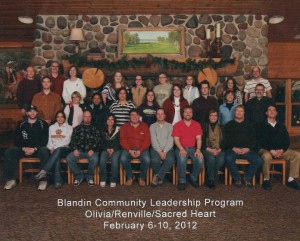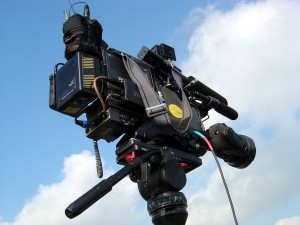In February 2012, Matt Baumgartner, General Manager at Baumgartner Environics, and other residents from Olivia, MN and surrounding areas participated in a 5-day leadership retreat put on by the Blandin Foundation. We asked Matt to share his experience with the Blandin Community Leadership Training. Here is his insight.
What made you decide to participate in the Blandin Training?
I received a letter from the Blandin Foundation, at the recommendation of other local Blandin graduates. At the time I didn’t know much about the program. I began asking others in the community about Blandin and received positive feedback, but it was my uncle who tipped the scales. He really encouraged me to attend. I have always been interested in improving myself and my surroundings. Blandin training gives a person tools and a network to achieve that goal.
How will your Blandin Training benefit your community?
During our training I joined a group with three other Olivian’s: Kevin Ayers, Nancy Standfuss, and Susie  Lang. The four of us decided to address an issue dogging our community: Sustainable Funding for Corn Capital Days (check out the Corn Capital Days Facebook page for more info). Our beloved annual hometown celebration, Corn Capital Days is in danger of disappearing because certain sources of funding have dried-up. We are employing our newly acquired Blandin skills and spearheading an effort to solve the funding issue. In summary we’ve framed the issue so the community understands what’s at stake, we’re bring together all those parties that have a stake in seeing Corn Capital Days continue, and mobilizing people and resources to maintain the effort.
Lang. The four of us decided to address an issue dogging our community: Sustainable Funding for Corn Capital Days (check out the Corn Capital Days Facebook page for more info). Our beloved annual hometown celebration, Corn Capital Days is in danger of disappearing because certain sources of funding have dried-up. We are employing our newly acquired Blandin skills and spearheading an effort to solve the funding issue. In summary we’ve framed the issue so the community understands what’s at stake, we’re bring together all those parties that have a stake in seeing Corn Capital Days continue, and mobilizing people and resources to maintain the effort.
What did you find the most interesting about the Blandin Training?
I really enjoyed the way they taught us to think about conflict. So often, conflict dominates people’s thoughts. Most of us seek to avoid conflict, even when the conflict is only imagined. Blandin has a very clever way to categorize conflict into four quadrants that hinge on the importance of an issue versus a relationship. For example, if I have a disagreement with my wife about what color to paint a room, I would accommodate her wish, because to me, the issue is unimportant and the relationship is most important. If the issue was much more important than the relationship, it would be a conflict.
What do you want others to know about the Blandin Training?
I recommend to anyone, no matter what part of life you are in, to attend Blandin Training. They teach a valuable skill set, and you get to know a whole group of great people.
The Blandin Community Leadership Program (BLCP) has provided leadership training for more than 6000 community leaders from more than 425 rural Minnesota communities, with the goal of developing and training a broad base of local leaders to build healthy communities.





